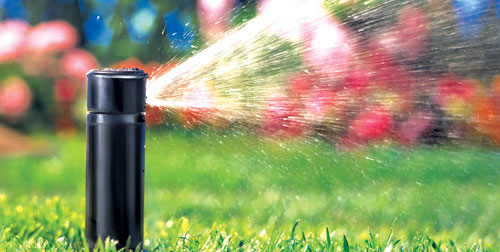Sprinkler Types
Spray systems are the most popular form of irrigation for home lawns and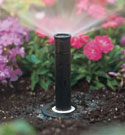 gardens, and are most advantageous for small yard areas. The nozzles are easily changed to accommodate different spray positions, and the system in general is quite dependable, requiring little maintenance. Spray systems are also ideal for weak pressure systems. The spray can throw a continuous stream of water from zero to fifteen feet. The only real disadvantage of a spray system is the wind factor, as high breezes lift the spray away from its target area. Rotary systemsare most frequently used for large areas and are commonly seen on athletic fields.
gardens, and are most advantageous for small yard areas. The nozzles are easily changed to accommodate different spray positions, and the system in general is quite dependable, requiring little maintenance. Spray systems are also ideal for weak pressure systems. The spray can throw a continuous stream of water from zero to fifteen feet. The only real disadvantage of a spray system is the wind factor, as high breezes lift the spray away from its target area. Rotary systemsare most frequently used for large areas and are commonly seen on athletic fields.
Rotary systems throw one or more streams of water up to 100 feet. This 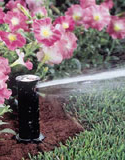 system is advantageous to cover large areas in which a high number of spray heads would be impractical. Despite the velocity of the water from the sprayer, rotary systems actually produce less water than spray systems. The same-sized area on a rotary system would have to be watered four times more frequently than with a spray system. Also, rotary systems are prone to sticking -- watering in one direction without rotation. The heads used on rotary systems include gear driven, ball driven and impact devices. As the name suggests, gear driven heads use internal gears to rotate the head, while the ball driven head uses a small ball rotating in the head. Impact devices have the gear actually strike itself to rotate the head. Flood systems are those that irrigate low to the ground. Bed sprays, bubblers and jet systems are all types of flood irrigation.
system is advantageous to cover large areas in which a high number of spray heads would be impractical. Despite the velocity of the water from the sprayer, rotary systems actually produce less water than spray systems. The same-sized area on a rotary system would have to be watered four times more frequently than with a spray system. Also, rotary systems are prone to sticking -- watering in one direction without rotation. The heads used on rotary systems include gear driven, ball driven and impact devices. As the name suggests, gear driven heads use internal gears to rotate the head, while the ball driven head uses a small ball rotating in the head. Impact devices have the gear actually strike itself to rotate the head. Flood systems are those that irrigate low to the ground. Bed sprays, bubblers and jet systems are all types of flood irrigation. 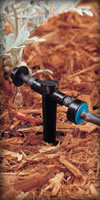
Flood systems work well for plants, such as roses, that have adverse affects to damp foliage. Bubblers and jets are limited to the type of soil conditions in which they operate. Sandy conditions would cause the water to sink on impact rather than spread throughout the garden. Heavy clay soil, however, would cause immediate run-off. The reduced water flow from flood systems is not effective for large lawn areas. Any system that generates a low volume of water is classified as a micro-irrigation system.Typical micro-irrigation systems include drip, trickleand some spray heads.
 Micro-irrigation is ideal for small areas of plants whose foliage cannot be sprayed. The water supply drips or trickles from plastic tubing close to the root, never touching the plants' leaves. This system is high maintenance, however. Tubing is often covered by mulch or plant foliage and the orifices can easily become clogged. Even the most diligent gardeners might not realize a clog in their micro system until the affected plants begin to show signs of stress. If not properly laid, the tubing can be unsightly and is easy prey for mowers and vandalism. The tubes are also known to break in freezing weather.
Micro-irrigation is ideal for small areas of plants whose foliage cannot be sprayed. The water supply drips or trickles from plastic tubing close to the root, never touching the plants' leaves. This system is high maintenance, however. Tubing is often covered by mulch or plant foliage and the orifices can easily become clogged. Even the most diligent gardeners might not realize a clog in their micro system until the affected plants begin to show signs of stress. If not properly laid, the tubing can be unsightly and is easy prey for mowers and vandalism. The tubes are also known to break in freezing weather.
The use of a professional in your irrigation project doesn't mean that you cannot play an active role in implementing your new system.
The four irrigation systems are only the beginning, and research on valve types and controller options will go a long way to ensuring that you receive the irrigation system that works best for you. (Thanks to /la.essortment.com)
No matter how simple or complex the landscape, Water Works has the sprinkler family to cover every angle. Rule of Thumb: Select long spray radius sprinklers for large areas so you can use fewer sprinklers and valves, which results in less pipe, less trenching -- and fewer timer zones. The basic sprinkler types include Fixed Spray, MultiStream and SingleStream.
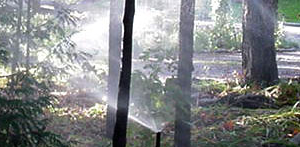 Water Works Irrigations
Water Works Irrigations 